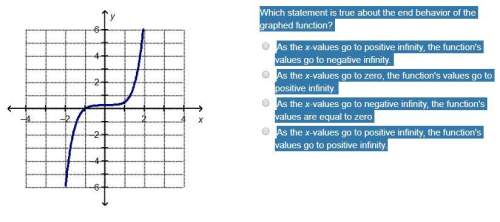
Mathematics, 21.09.2019 13:30, asorrell5075
Which statement is true about the end behavior of the graphed function? as the x-values go to positive infinity, the function's values go to negative infinity. as the x-values go to zero, the function's values go to positive infinity. as the x-values go to negative infinity, the function's values are equal to zero as the x-values go to positive infinity, the function's values go to positive infinity.


Answers: 1
Other questions on the subject: Mathematics

Mathematics, 21.06.2019 20:20, maxi12312345
Aline passes through (1,-5) and(-3,7) write an equation for the line in point slope form rewrite the equation in slope intercept form
Answers: 1

Mathematics, 21.06.2019 20:30, esnyderquintero
Find the area of the triangle formed by the origin and the points of intersection of parabolas y=−3x^2+20 and y=x^2−16.
Answers: 3


Mathematics, 22.06.2019 02:40, simran922
Exercise: counting committees 0.0/2.0 puntos (calificable) we start with a pool of n people. a chaired committee consists of k≥1 members, out of whom one member is designated as the chairperson. the expression k(nk) can be interpreted as the number of possible chaired committees with k members. this is because we have (nk) choices for the k members, and once the members are chosen, there are then k choices for the chairperson. thus, c=∑k=1nk(nk) is the total number of possible chaired committees of any size. find the value of c (as a function of n ) by thinking about a different way of forming a chaired committee: first choose the chairperson, then choose the other members of the committee. the answer is of the form c=(α+nβ)2γn+δ. what are the values of α , β , γ , and δ ?
Answers: 3
Do you know the correct answer?
Which statement is true about the end behavior of the graphed function? as the x-values go to posit...
Questions in other subjects:



Social Studies, 20.05.2021 17:30


Mathematics, 20.05.2021 17:30


Mathematics, 20.05.2021 17:30



History, 20.05.2021 17:30






